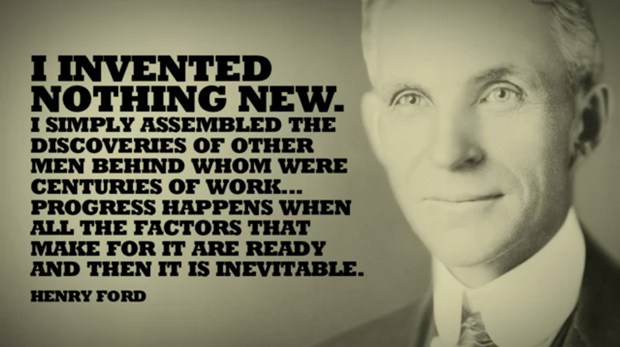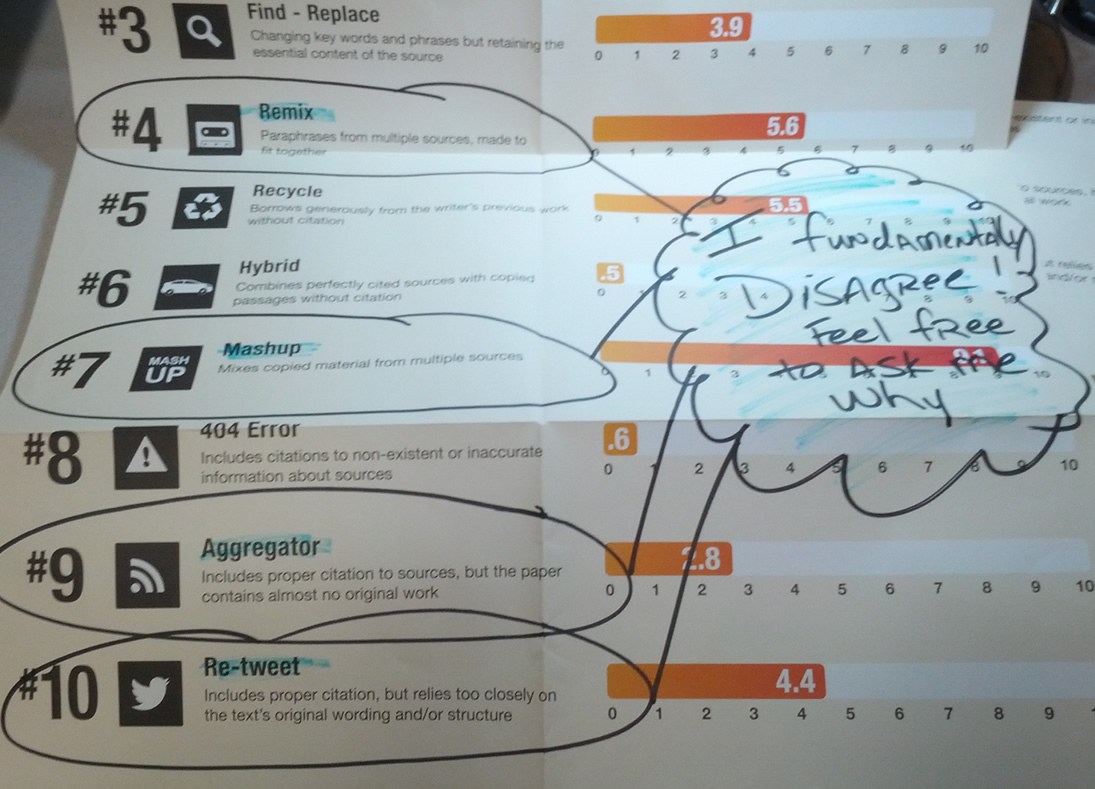Remix, Mashups, Aggregation, Plagiarism Oh My
Editor's Note
This was originally posted to Clint Lalonde's blog on November 28, 2012.
I am about to criticize and show examples from a copyright poster (or, for you new-fangled kids, an infographic) I received in the mail today from Turnitin, the anti-plagiarism company. Fair dealing y’all.
The title of the poster is The Plagiarism Spectrum: Tagging 10 Types of Unoriginal Work, and lists the top 10 types of plagiarism based on the findings of a global survey of nearly 900 secondary and higher education instructors. The poster ranks the severity of the offense (#1 being highest level of severity, 10 the lowest) and shows a scale of 1-10 based on how often each type of plagiarism appeared in the survey results. I tried to catch a full size shot of the poster (you can click the image for a larger, more detailed version):
Well, I have some problems with this. Let’s zoom in on the areas I find troublesome.
and
Remixing is the 4th most nefarious form of plagarism, and mashups are #7…at least according to these 900 teachers and instructors. This saddens me because I happen to consider these two activities some of the most creative and original cultural acts happening today. And to think there are 900 some instructors and teachers out there who do not recognize the creative value and sheer amount of work it takes to create something new and original out of what existed before.
Quite frankly, it astonishes me that in this day and age, remix and mashups are thought of as plagiarism. I am of the school that everything is a remix.
History is populated with examples where multiple ideas, products, music, literature, you name it were mashed-up, remixed and otherwise recontextualized to create something completely new and original. As Brian Lamb puts it in his 2007 Educause article Dr. Mashup; or, Why Educators Should Learn to Stop Worrying and Love the Remix:
Elements of reuse have always been present in creative work, even though the borrowing may have been framed in terms of “tradition,” or “influence.” Artistic and scholarly works build on the work of others.
Yet, according to this study, we in education consider these acts of stealing; of unoriginal thought. Plagiarism. Laziness. Look at how lazy these remix people are. They work in bed in their pyjamas for crying out loud.
No good can ever come out of that.
If this is the true and accurate sentiments of educators in general – that remix is, in fact a form of plagiarism – then it makes me realize just what kind of uphill battle we might face here in British Columbia as we move towards creating and modifying Open Textbooks. The challenge being that if educators have this underlying core value that remixing someone else’s content to create something new is plagiarism, then they are coming into the open text book project with the preconceived notion that we have to build something from scratch; reuse is not an option because it is plagiarism.
For me, this is the wrong way to approach an open textbook project. In order for the open textbook initiative to be successful, I think we need educators to come to the table with an open mind about reuse and remixing existing materials; to modify already existing open textbooks and openly licensed content to fit their specific needs. Not only do I think that starting from scratch is an arrogant place to begin (we are the only ones who know best), I think that if we try to recreate the wheel and start from scratch, we start at the bottom of the hill and put a big boulder in the way. Anyone who has written anything at length knows that it is much easier editing and modifying than staring at a blank piece of paper in the typewriter.
I also have a problem that this:
and this:
are practices being painted with the plagiarism brush.
A retweet serves many purposes, not the least of which is attribution. If someone retweets something that I send out and keeps my Twitter handle in the tweet, I am notified. It is a signal to me that they find what I tweeted valuable – so valuable that they wish to share it with the people in their network. For the person being retweeted, this underlying message you receive when someone retweets one of your tweets is that the people in your network find that type of content valuable. It is a prompt to share more. We all know how important knowing your audience is in communication and writing, and a retweet is a signal back to the original source that someone in the audience found the content valuable, please share more like this. Retweets serve an important function in that it helps me know my audience.
Aggregation is, in essence, curation, a skill that I think is incredibly important in education. There is great skill to being a good curator of resources; a filter. I value the curators in my network. As educators, we constantly curate resources. It is one of the core learning activities we do – vet resources for our learners and point them in the direction of what we think is important. This is what aggregations is all about.
But the biggest problem I have with this poster is that it brings all of these things together in one handy, scary resource, and makes these practices appear fraught with danger, when in fact, I believe these are core skills required to create understanding in today’s world. This poster is being sent out to other educators like myself in the hopes that it will get posted in a hallway or office so that other educators will see this. The underlying message they take away after viewing this poster is that these practices: Remix, Mashup, Aggregation and Retweet are riddled with risk (thanks, Tracy for helping me articulate this). That whatever positive purpose they may serve in an educational context, the risk is not worth it. And I fundamentally disagree with that.
So, I am going to hang this poster in my office and I am going to use it to trigger a conversation. But I am going to modify it a bit.
This content is provided to you freely by EdTech Books.
Access it online or download it at https://edtechbooks.org/wild/plagiarism_oh_my.









